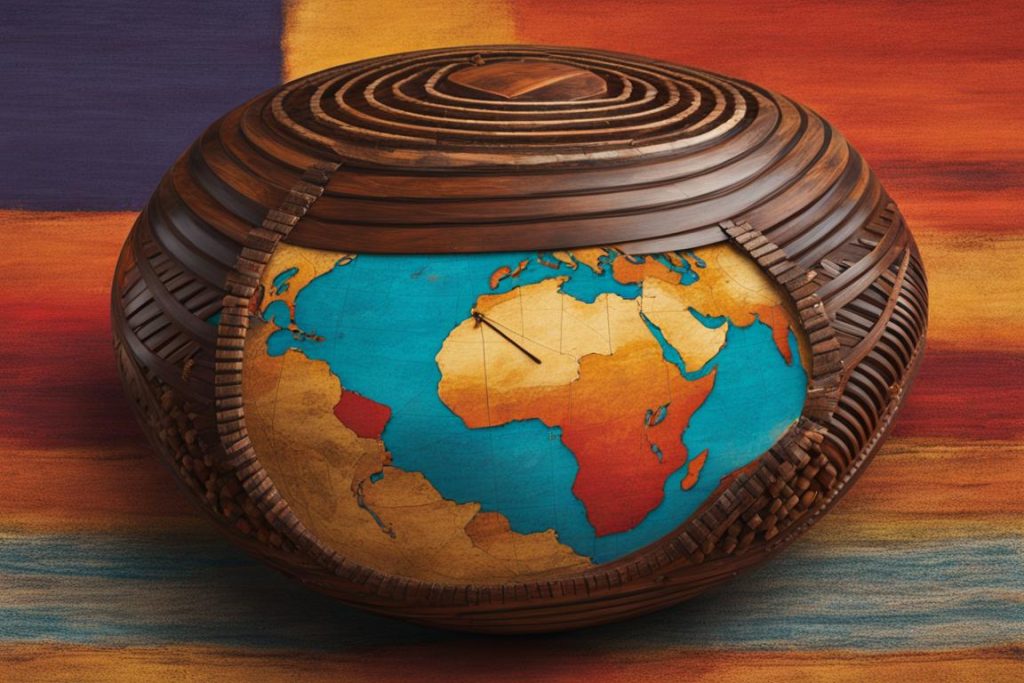Welcome to the fascinating world of the cabasa instrument! If you’ve ever been curious about the cabasa instrument origin and history, you’ve found yourself at the exact place you’re looking for
In this article, we’ll delve into the origin and roots of the cabasa, shedding light on its intriguing journey through time and diverse cultures.
Content
Traditional Roots and Cultural Significance of Cabasa Instrument
The cabasa instrument has deep traditional roots and holds cultural significance in various regions. In Spain, the instrument known as the cadenas, meaning chains, is made of iron chains used as a percussion instrument.
In Portugal and Brazil, the caixa and caixeta are wood block percussion instruments. The caja, a snare drum, is commonly used in Spain and Spanish-speaking America.
The cabasa has evolved from these traditional instruments and has found its place in modern music.
The evolution of the cabasa instrument can be seen in its construction and design. Originally made of iron chains, it has transformed into a stainless steel cylinder with metal ball chains wrapped around it.
This evolution has allowed for a more controlled and versatile sound production, making the cabasa a valuable tool for percussionists.
The cultural significance of the cabasa instrument lies in its connection to traditional music and the communities that embrace it. It represents a piece of heritage and identity, carrying the rhythms and melodies of generations past.
The cabasa’s inclusion in modern music allows for the preservation and celebration of cultural traditions while also adapting to contemporary musical expressions.
| Traditional Instruments | Country |
|---|---|
| Cadenas | Spain |
| Caixa | Portugal |
| Caixeta | Brazil |
| Caja | Spain, Spanish-speaking America |
Global Journey and Musical Heritage
The cabasa instrument’s rich history and roots extend far beyond its origins in South America and Spain. This unique percussion instrument has embarked on a global journey, captivating musicians and cultures around the world.
One notable influence on the cabasa’s global appeal came from Brazilian percussionist Rubem Dantas, who introduced the Peruvian cajón, a similar instrument, to Spanish flamenco music.
Since then, the cabasa has become an essential component of contemporary flamenco music, contributing to its widespread recognition and traditional use.
Additionally, the cabasa’s origins have had a profound impact on other genres and traditions.
Its influence can be heard in Afro-Peruvian music, where its rhythmic patterns and distinct sound have woven themselves into the fabric of this vibrant musical style. Modern Spanish flamenco also showcases the cabasa’s unique contributions, enriching performances and adding depth to the genre’s dynamic compositions.
These diverse musical expressions highlight the versatility and adaptability of the cabasa, and its growing popularity among percussionists worldwide is a testament to its significant musical heritage.
| Country/Region | Traditional Use |
|---|---|
| Brazil | Samba, Bossa Nova |
| Peru | Afro-Peruvian Music |
| Spain | Flamenco |
| United States | Jazz, Latin, World Music |
Origins and Globalization of Cabasa

The cabasa instrument has a rich history that can be traced back to its origins and the globalization of music.
Brazilian percussionist Rubem Dantas played a pivotal role in introducing the cabasa to the Spanish flamenco scene, sparking its popularity among flamenco performers.
Today, the cabasa instrument is not limited to a specific region or musical tradition. Percussionists from around the world have recognized its unique sound and versatility, incorporating it into different genres and musical styles.
The globalization of music has played a significant role in spreading the influence and use of the cabasa instrument.
Its distinctive sound adds a rhythmic texture to various ensembles and compositions, making it a valuable addition to contemporary music.
Whether it’s jazz, Latin, or world music, the cabasa’s origins and globalization have firmly established its presence in the global music scene.
| Section | Description |
|---|---|
| Origin | The cabasa instrument originated from South America and has evolved from other percussion instruments such as the caixa, caja, and cajón. |
| Globalization | The introduction of the cabasa to Spanish flamenco by Brazilian percussionist Rubem Dantas contributed to its popularity worldwide. |
| Versatility | Percussionists from different musical traditions and genres embrace the cabasa instrument for its unique sound and rhythmic capabilities. |
| Contemporary Presence | The cabasa instrument continues to be widely used in various contemporary music genres, adding percussive elements and rhythmic textures. |
Cabasa in Contemporary Music
The cabasa instrument, with its rich origins in South American and Spanish music, has successfully made its way into the realm of contemporary music.
This versatile percussion instrument has transcended boundaries and become a prominent feature in a wide range of genres, including jazz, Latin, and world music.
One of the key uses of the cabasa in contemporary music is its ability to create unique rhythmic textures.
The stainless steel cylinder, wrapped with metal ball chains, produces a distinct sound when scraped, adding a percussive layer to ensemble performances.
Whether it’s the nuanced beats of jazz or the energetic rhythms of Latin music, the cabasa brings a dynamic element to the composition.
However, it is the traditional roots and traditional use of the cabasa that provide the instrument with its timeless appeal.
What originated as a South American rattle has found a place in modern music due to its ability to evoke a sense of authenticity and cultural heritage.
Musicians recognize the significance of incorporating traditional instruments into their compositions, and the cabasa offers a compelling choice.
As contemporary music continues to evolve, the cabasa remains an essential tool for percussionists and musicians alike.
Cabasa instrument origin and traditional use contribute to its enduring popularity, while its adaptability allows it to seamlessly blend into various musical styles.
Whether you’re tapping into the rich heritage of South American rhythms or exploring the vibrant sounds of Latin music, the cabasa instrument is a valuable addition to your musical repertoire.
